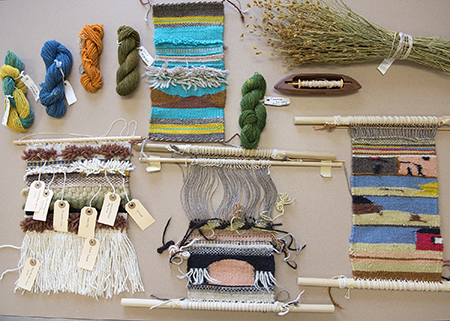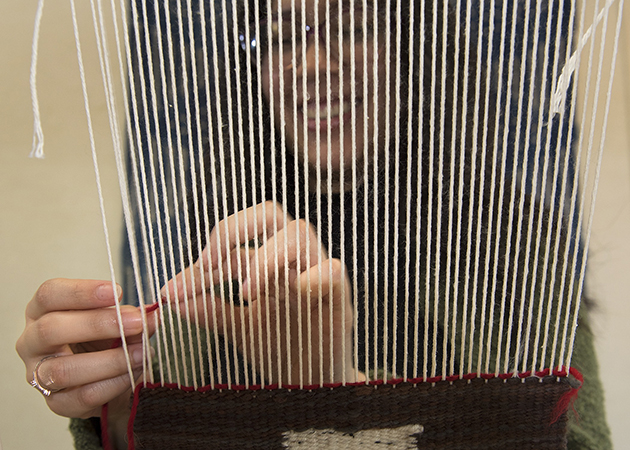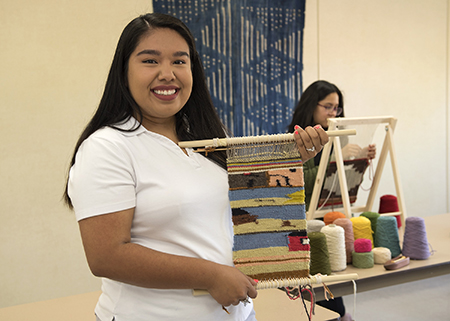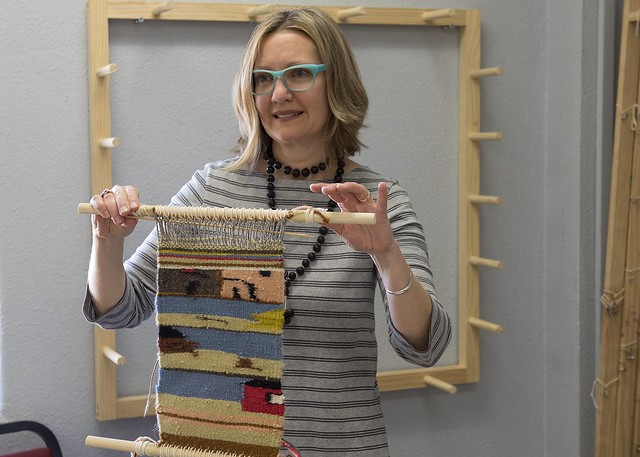Today@Sam Article
Family And Consumer Sciences Team Learns Indigenous Weaving Process
April 12, 2018
SHSU Media Contact: Emily Binetti
| In the summer of 2017, a team from the Department of Family and Consumer Sciences travelled to New Mexico for an unforgettable experience. |
Story by Tyler Pointer
Stories often appear to us in the form of words. In our favorite books, we travel to a world unbeknownst to us and can let our imagination take control of the tide. We see stories when we turn on our television screens and effortlessly let the tales unfold before us. However, for the Navajo and Chimayo cultures, the art of storytelling has been woven into their culture for thousands of years.
Trish Ramsay, clinical assistant professor of Design at Sam Houston State University, had the opportunity to learn directly from the source on the art of Navajo and Chimayo weaving along with two of her students.
Ramsay traveled to New Mexico with Fashion Merchandising majors Noemi Monjaras and Beatriz Zapata to research and understand the roots of Navajo and Chimayo weaving within its cultural context.
“It’s wonderful to have the opportunity to focus solely on a research project such as this,” Ramsay said. “To have an immersive experience in one subject, to look more closely at the details, and to take one’s time to better understand what we are learning makes a huge difference in how our learning can impact our lives in a positive way. It’s great that SHSU is able to provide grant opportunities for faculty and students that will have a long-term effect on our futures.”
| Beatriz Zapata shows her rendition of the classic fairytale "The Three Little Pigs." |
The research team received the FAST Grant, which allowed Monjaras and Zapata to travel to New Mexico and directly assist Ramsay in the research.
The adventure consisted of four days of interviews with museum experts, Nicolasa Chavez and Joyce-Begay-Foss, archeo-botanist Glena Dean, 7th generation weaver Irvin Trujillo and contemporary weaver Dean Daller. It finished with four days of a diligent weaving workshop with master Dine weaver Roy Kady, according to Monjaras.
“Learning about traditional weaving and dye processes is significant to me because I believe it is important to understand the cultural aspects of a textile embedded through the production,” Monjaras said. “One topic of interest that I am passionate about is the problem of cultural appropriation. Learning about these things from contemporary weavers and generational weavers puts many things into perspective and allows for more conversations about the issue.”
Like Monjaras mentions, Navajo and Chimayo patterns have been fabricated across the world and are often used as a fashion trend. The importance of weaving to these cultures is often lost within the fashion industry.
Through the trip, the team was able to not only understand, but completely immerse themselves in the stories of the Navajo weaving process.
“The beauty in this is that weaving is not restrictive to ability, rather the will to do it,” Zapata said. “We were all fortunate enough to attend the intensive workshop with Roy Kady at the Española Valley Fiber Arts Center in New Mexico. We learned that weaving is universal. Even if you do not consider yourself artistic in any sense, weaving provides that creative outlet that everyone needs.”
Ramsay felt her own personal growth as a professor and researcher from the experience and applies her knowledge to the classroom.
“As an educator, I believe it is important to learn about our regional cultures,” Ramsay said. “I have a better understanding of how New Mexican weaving traditions were and are shaped by Native American and Spanish Colonial influences. Along with this, I also have a new visual and technical vocabulary in weaving that I share with students in my textile design course.”
This semester Ramsay is using indigo dyeing processes with her students to engage underserved populations in Walker County in the Academic Community Engagement (ACE) course entitled “Textiles and Print: Building Communities.”
Monjaras and Zapata will present some of their research in April at the Undergraduate Research Symposium that will summarize their experience and how it provides cultural context on the importance of woven textiles and the roles they play today.
The unforgettable experience shaped three different patterns into the future of the trio as students and researchers.
“Originally, I had hoped that this experience would aid my academic career for my future pursuit of a graduate degree in fashion merchandising,” Monjaras said. “However, going there and speaking with all sorts of people made me realize that I enjoy interacting and learning up-close and how the environment-both the tangible and intangible- changes people. It awakened my interests in anthropology, semiotics, and design ethnology.”
Zapata was blindsided by her experience, but recognizes the self-growth and awareness it instilled within her.
“Throughout this trip and research experience, I was fortunate enough to discover the importance of self,” Zapata said. “When weaving there is a cultural and spiritual aspect. The first few lines of a weaving are called ‘spirit lines’ and it is encouraged that when you start, to do a small prayer, song, and whatever you desire, to the Creator. So that he may guide you in your weaving. At first this was strange, as an outsider coming in, because I had assumed that designs were preset. In true Navajo weaving, the design comes to you as you are making it. I found an inner peace from this.
“Through the intensive workshop I found my calling in servant leadership. ‘The measure of a Life is its Service,” was just a motto to me, but after these events I understand the actual depth and meaning behind it. As I helped others in the workshop, I found immense joy in seeing others reach new milestones in their weavings and within themselves.”
In addition to this research project is a lecture on the pre-Columbian farming practices in New Mexico, presented by Glenna Dean, former state archaeologist of New Mexico. The lecture will take place at 4 p.m. on April 19 in Lee Drain Building Room 214 and is co-sponsored by the Department of Family and Consumer Sciences and the Department of Biology.
For additional information contact Ramsay at Tramsay@shsu.edu.
- END -
This page maintained by SHSU's Communications Office:
Director of Content Communications: Emily Binetti
Asst. Director Content & Social Media: Emilee White
Communications Manager: Mikah Boyd
Telephone: 936.294.1837
Communications Specialist: Campbell Atkins
Telephone: 936.294.2638
Please send comments, corrections, news tips to Today@Sam.edu



